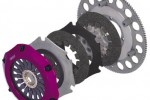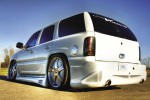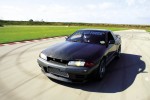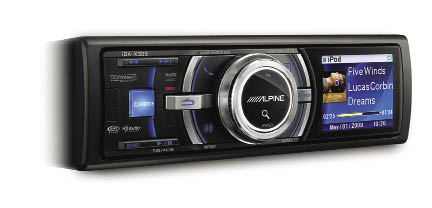CONTROLS AND FUNCTIONS
Alpine has been among the best brands for developing intuitive controls that take a minimum of manual reading to use, and for incorporating the most frequently used functions in a way that minimizes the amount of time you have to take your eyes off the road. Having said that, when you first install and set up the Alpine iDA-X305, you should probably read the owners manual anyway, because it comes on a CD, and can’t be carried in the car for later reference.
The “double action encoder” is large, easy to find without looking, and has a nice feel to it, but I can’t say I think it’s good looking. Located in the center of the unit, the big silver knob reminds me of the loathsome multifunction controllers found in way too many German cars… BMW and Mercedes in particular. But unlike the troublesome Teutonic tactics the Alpine’s knob is intuitive and simple to understand after a very short time.
Stepping through the setup and control functions, I found some very useful tone controls, with independently selectable frequencies for bass and treble, as well as a welcome ability to adjust the “Q” of the bass boost. Each tone control level adjustment has 15 steps, so getting things dialed in should be simple. A nice loudness contour is also selectable, and a high pass filter is included, providing 3 frequencies to choose from, or you can simply leave it off. You can also turn the internal amplifier on and off via the setup menu. Should you desire even more control of your audio, the Alpine iDA-X305 is fully compatible with Alpine’s excellent IMPRINT audio processor. A single button press switches the display to a very large clock calendar display, for those of you who don’t know what time it is…you will. I also liked the “any button wake up” feature, where touching any button will turn the unit on.
Setting up my Blackberry on the Bluetooth adapter was quick and easy, and it worked the first time. In a few seconds my data was downloaded to the radio, and I was able to fully make and take calls via the headunit. Don’t cha love it when stuff just works?
LISTENING
After I got the Alpine iDA-X305 and my favorite iPod hooked up in my listening room’s reference system, I sat down to really play with the controls, and listen to the unit. I began with a playlist of good quality recordings from various audiophile CDs, (these are AAC and MP3 files at 320kbits) and did some listening. The iDA-X305 retains the slightly irksome Alpine requirement of having to turn the volume up to about 65% to get useful output out of it, and it takes several rotations of the encoder to get there. It’s not a big deal, but just one of those little niggles you have to put up with in daily use. On the upside though, the small increments in volume do provide very precise control and is easy to get used to.
The iPod interface works flawlessly, and the Quick Search feature allows fast access to your tunes. I then switched over to a USB drive with the same songs on it, and the performance was also excellent in terms of search, playback and control. The AM/FM tuner also provided good reception, and performed as good or better than most inside my listening room. It pulled in all the usual local stations with good clarity and low noise.
Sonically, I came away with the impression that the Alpine DMR sounded very good, which may be at least in part due to their selection of a 24 bit Burr-Brown DAC. I did notice I needed a bit of additional gain at my amplifier, which indicated an output voltage lower than what I normally have. Switching to the internal amplifier, the very good sonics continued, although I have to say if you are going to spend the money on a great new head unit, listening to the built in amplifier probably isn’t going to do it justice. Alpine uses a very good internal amplifier to be sure, but 18 or 20 watts per channel isn’t enough for any hardcore audio enthusiast’s ride.
ON THE BENCH
The next morning, I connected the Alpine to my test bench, and measured the actual performance specs. As I suspected, the output voltage was only marginally adequate at 2.2 volts RMS, although the other specifications measured very good to excellent. Great specs elsewhere help, but output voltage is very important, because it allows good signal transfer over the vehicles noisy chassis with a minimum of degradation, and a high signal voltage permits minimal gain required at the amplifier. This provides the best possible noise immunity and dynamic range. I generally won’t consider a headunit truly high performance unless it has at least 4 volts of output, but given that most people don’t exactly have top notch MP3 file quality anyway, I suppose I can understand Alpines decision to go with a standard output voltage.
The internal amplifier exceeded the CEA-2006 rated power, and the S/N measurements for both the amplified outputs and the preamp outputs also exceeded the rated spec. Distortion at rated power was also very low, and the frequency response, (measured using a 320k/bs AAC track on a USB drive) was reasonably flat as well.
 |
 |
 |
 |
 |
If you are the type of person who never wants to see another CD, needs a good sounding headunit with a vast array of convenience features and adjustability, plus a very good Bluetooth interface, you’ll like the Alpine iDA-X305 and the separate KCE-400BT.”
www.alpine-usa.com
www.alpine-canada.com
Related Articles
 Project R32: Proper Exedy Racing Clutch Selection
Project R32: Proper Exedy Racing Clutch Selection
 Getting Hyphy: Calvin Wan's 1993 Mazda RX-7
Getting Hyphy: Calvin Wan's 1993 Mazda RX-7
 BIG BALLIN'
BIG BALLIN'
 Rugrat: Sean Driscoll's 2004 Scion xB
Rugrat: Sean Driscoll's 2004 Scion xB
 Project R32: Adjustable Suspension Links
Project R32: Adjustable Suspension Links
 Serge Leger's Team ETC 2009 Cadillac CTS
Serge Leger's Team ETC 2009 Cadillac CTS



